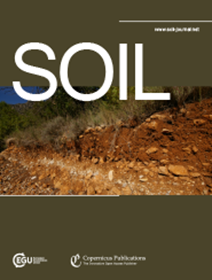Exploring the link between cation exchange capacity and magnetic susceptibility
IF 4.3
2区 农林科学
Q1 SOIL SCIENCE
引用次数: 0
Abstract
Abstract. This study explores the relationship between soil magnetic susceptibility (κ) and cation exchange capacity (CEC) across diverse European soils, aiming to enhance pedotransfer functions (PTFs) for soil CEC using near-surface electromagnetic geophysics. We hypothesize that soil κ, can improve the prediction of CEC by reflecting the soil's mineralogical composition, particularly in sandy soils. We collected data from 49 soil samples in vertical profiles across Belgium, the Netherlands, and Serbia, including κ in situ conditions (κ∗), low and high frequency κ in the laboratory, in-site electrical conductivity (σ), iron content, soil texture, humus content, bulk density, water content, water pH, and CEC. We used these properties as features to develop univariable and multivariable (in pairs) polynomial regressions to predict CEC for sandy and clayey soils. Results indicate that κ∗ significantly improves CEC predictions in sandy soils, independent of clay content, with a combined κ∗-σ model achieving the highest predictive performance (R2 = 0.94). In contrast, laboratory-measured κ was less effective, likely due to sample disturbance. This study presents a novel CEC PTF based on σ and κ∗, offering a rapid, cost-effective method for estimating CEC in field conditions. While our findings underscore the value of integrating geophysical measurements into soil characterization, further research is needed to refine the κ–CEC relationship and develop a more widely applicable model.探讨阳离子交换容量与磁化率之间的关系
摘要。本研究探讨了不同欧洲土壤磁化率(κ)与阳离子交换容量(CEC)之间的关系,旨在利用近地表电磁地球物理增强土壤CEC的土壤传递函数(ptf)。我们假设土壤κ可以通过反映土壤的矿物组成来改善CEC的预测,特别是在沙质土壤中。我们收集了来自比利时、荷兰和塞尔维亚的49个垂直剖面土壤样品的数据,包括原位κ条件(κ∗)、实验室低频和高频κ、现场电导率(σ)、铁含量、土壤质地、腐殖质含量、体积密度、含水量、水pH和CEC。我们利用这些特性作为特征,开发了单变量和多变量(成对)多项式回归来预测砂质和粘土的CEC。结果表明,κ∗显著提高了砂质土中CEC的预测效果,与粘土含量无关,其中κ∗-σ组合模型的预测效果最高(R2 = 0.94)。相比之下,实验室测量的κ不太有效,可能是由于样本干扰。本研究提出了一种基于σ和κ *的新型CEC PTF,提供了一种快速、经济的方法来估计现场条件下的CEC。虽然我们的研究结果强调了将地球物理测量整合到土壤表征中的价值,但需要进一步研究以完善κ-CEC关系并开发更广泛适用的模型。
本文章由计算机程序翻译,如有差异,请以英文原文为准。
求助全文
约1分钟内获得全文
求助全文
来源期刊

Soil
Agricultural and Biological Sciences-Soil Science
CiteScore
10.80
自引率
2.90%
发文量
44
审稿时长
30 weeks
期刊介绍:
SOIL is an international scientific journal dedicated to the publication and discussion of high-quality research in the field of soil system sciences.
SOIL is at the interface between the atmosphere, lithosphere, hydrosphere, and biosphere. SOIL publishes scientific research that contributes to understanding the soil system and its interaction with humans and the entire Earth system. The scope of the journal includes all topics that fall within the study of soil science as a discipline, with an emphasis on studies that integrate soil science with other sciences (hydrology, agronomy, socio-economics, health sciences, atmospheric sciences, etc.).
 求助内容:
求助内容: 应助结果提醒方式:
应助结果提醒方式:


